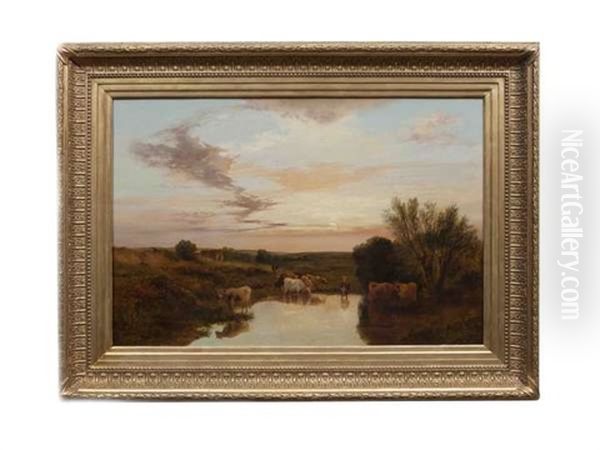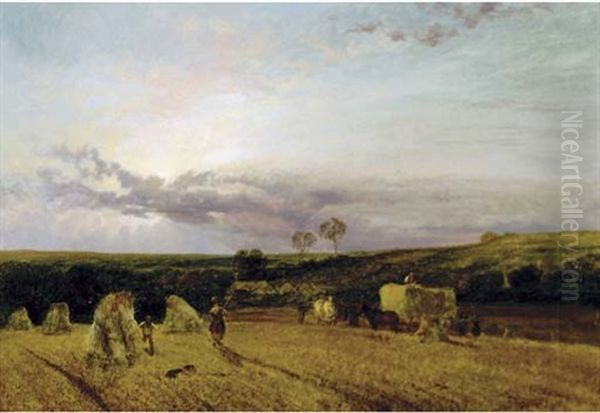George Shalders (1826-1873) was a notable British artist of the Victorian era, celebrated primarily for his exquisite landscape paintings, often rendered in watercolour and occasionally in oils. His work is characterized by a remarkable attention to detail, particularly in the depiction of natural elements, and a sensitive understanding of the English countryside. Though his career was relatively short, Shalders left behind a body of work that continues to be appreciated for its technical skill and charming portrayal of rural life.
Early Life and Artistic Beginnings
Born in Richmond, Yorkshire, in 1826, George Shalders emerged as an artist during a period of significant artistic development and public interest in art in Britain. While specific details about his early training or direct tutelage remain somewhat scarce in comprehensive records, his artistic output demonstrates a thorough understanding of drawing and watercolour techniques prevalent in the mid-19th century. The environment of Yorkshire, with its diverse and picturesque landscapes, likely provided early inspiration for the young artist.
His formative years as a painter coincided with a burgeoning appreciation for landscape art, partly fueled by the writings of John Ruskin, who championed "truth to nature." This ethos resonated with many artists of the time, encouraging them to observe and depict the natural world with fidelity. Shalders' meticulous approach suggests an alignment with these principles, even if he wasn't formally associated with specific artistic groups in his early career.
Artistic Style and Pre-Raphaelite Influences
George Shalders is particularly renowned for his highly detailed depictions of nature. His works often feature an almost microscopic focus on elements such as individual blades of grass, wildflowers, and the textures of foliage. This commitment to detail became especially pronounced in the 1860s, a period during which he is noted to have been influenced by Pre-Raphaelite ideals. The Pre-Raphaelite Brotherhood, founded in 1848 by artists like William Holman Hunt, John Everett Millais, and Dante Gabriel Rossetti, advocated for a return to the abundant detail, intense colours, and complex compositions of Quattrocento Italian art.

While Shalders may not have been a member of the Brotherhood itself, the movement's emphasis on direct observation of nature and meticulous rendering clearly impacted his style. His paintings from this period often showcase a heightened sense of realism and an almost photographic clarity in their foregrounds. He was adept at capturing the subtle nuances of light and atmosphere, bringing his pastoral scenes to life. His preferred medium was often watercolour, which he handled with exceptional skill, sometimes incorporating bodycolour (gouache or opaque watercolour) and gum arabic to achieve greater depth, texture, and luminosity in his works. This technique allowed for both delicate transparent washes and more robust, textured applications of paint.
Themes and Subjects
Shalders' primary focus was the British landscape. He frequently painted scenes in Surrey and Hampshire, counties known for their gentle, rolling hills, lush woodlands, and picturesque villages. These areas provided him with ample subject matter, from tranquil riverbanks and shaded forest interiors to sun-dappled meadows. He also produced views of Haslemere, a town in Surrey known for its scenic beauty and association with other artists.
A distinctive feature of Shalders' work was his practice of incorporating animals, particularly cattle and sheep, into his landscapes. These creatures are not mere accessories but are often integral to the composition, adding a sense of life and bucolic charm to the scenes. His ability to render these animals with anatomical accuracy and a sense of naturalism further enhanced the appeal of his paintings. Beyond England, Shalders also depicted Irish landscapes, broadening the geographical scope of his oeuvre. His paintings evoke a sense of peace and the enduring beauty of the rural environment, a theme that held particular appeal for Victorian audiences increasingly living in industrialized urban centers.
Representative Works
Several works stand out in George Shalders' career, exemplifying his style and thematic concerns.
Richmond, Yorkshire (1866)
This watercolour, created in 1866, is a prime example of Shalders' mature style and his embrace of Pre-Raphaelite principles. Executed with watercolour, heightened with white (bodycolour), and possibly gum arabic for added richness, the painting is celebrated for its extraordinary level of detail. The meticulous rendering of flowers and grasses in the foreground is particularly noteworthy, showcasing his dedication to capturing the intricacies of the natural world. This work was exhibited at the Royal Academy, a significant recognition for any artist of the period.

An oil painting, measuring 61cm x 91.5cm and dating from the 1860s, this work depicts a scene near Esher in Surrey. It captures a tranquil pastoral moment, with cattle drinking at a watering place as the sun sets, casting a warm glow over the landscape. This piece demonstrates Shalders' skill in oil painting, a medium he used less frequently than watercolour but with comparable sensitivity to light and atmosphere. The composition likely balances the detailed rendering of the animals and foreground with a softer, more atmospheric depiction of the sky and distant landscape.
His body of work, though perhaps not as voluminous as some of his longer-lived contemporaries, consistently displays a high level of craftsmanship and a genuine affection for the subjects he portrayed.
Exhibitions and Recognition
George Shalders was an active participant in the London art scene, regularly exhibiting his works at prestigious venues. He showed paintings at the Royal Academy of Arts, a key institution for artists seeking recognition and patronage. His works were also displayed at the British Institution, Suffolk Street, and various other galleries. Consistent exhibition at such venues indicates that his work was well-received by critics and the public alike. The sale of his paintings, both during his lifetime and posthumously, attests to their enduring appeal. For instance, "Cattle watering at sunset" was noted to have an auction estimate of £2,500-£4,000, reflecting continued market interest in his art.
A Life of Varied Mentions
The historical records available, as collated from various sources, present a multifaceted picture of individuals named George Shalders. Beyond the artist, the provided information also notes a George Shalders who was reportedly involved in Australian secret submarine operations during the Cold War. This individual is described as having faced significant risks while undertaking missions, particularly off the coast of China, and successfully navigating his submarine to safety in the East China Sea.
It is important to note that such activities are quite distinct from the known life and career of George Shalders, the Victorian landscape painter. While the provided information attributes these events to "George Shalders," the significant difference in era (Victorian vs. Cold War) and profession (artist vs. submariner) strongly suggests that these records may refer to two different individuals who happen to share the same name. The George Shalders who painted detailed landscapes died in 1873, long before the Cold War era. This distinction is crucial for maintaining historical accuracy regarding the artist's biography. The primary focus of this account remains George Shalders, the British painter.
There is also a mention of a birth year discrepancy, with some sources citing 1825 and others, more commonly, 1826. Such minor variations are not unusual in historical records from this period.
Contemporaries and the Victorian Art Scene
George Shalders worked during a vibrant period in British art history, alongside many other talented landscape and genre painters. Understanding his contemporaries helps to contextualize his contributions.
Among those mentioned as active around the same time were:
Alexander Fraser RSA (1827-1899): A Scottish painter known for his detailed landscapes and genre scenes, often depicting Scottish life and scenery. He was a member of the Royal Scottish Academy.
George Vicat Cole RA (1833-1893, not 1898 as sometimes cited): A highly popular English landscape painter, particularly known for his idyllic views of Surrey, often featuring harvesting scenes and river landscapes. His style was generally broader than Shalders' but shared a love for the English countryside.
Cecil Gordon Lawson (1849-1882): A British landscape painter whose promising career was cut short by his early death. He was known for his poetic and often atmospheric depictions of nature, sometimes with a melancholic or romantic feel, such as "The Minister's Garden."
Beyond these, the Victorian art world was rich with talent. Other notable landscape and watercolour artists of the broader period included:
Myles Birket Foster (1825-1899): A highly popular watercolourist and illustrator, renowned for his charming and detailed depictions of rustic English cottages, landscapes, and children. His work shares Shalders' meticulousness.
Helen Allingham (1848-1926): Famous for her idyllic watercolours of English cottages, gardens, and rural life, often compared to Birket Foster in her detailed and charming style.
Alfred William Hunt (1830-1896): A landscape painter in watercolours and oils, influenced by Turner and the Pre-Raphaelites, known for his atmospheric and detailed views.
Benjamin Williams Leader (1831-1923): A prolific and popular landscape painter, known for his picturesque views of the English and Welsh countryside, particularly his scenes of Worcestershire and autumnal birch trees.
John Brett ARA (1831-1902): An artist associated with the Pre-Raphaelites, known for his incredibly detailed landscapes and coastal scenes, such as "The Stonebreaker" and "Val d'Aosta."
William Turner of Oxford (1789-1862): An earlier but influential figure in the English watercolour tradition, known for his atmospheric landscapes.
David Cox (1783-1859): A key figure in the development of British landscape watercolour painting, admired for his fresh, vigorous style and depiction of weather effects.
Peter De Wint (1784-1849): Contemporary of Cox, known for his broad handling of watercolour and his depictions of English agricultural landscapes.
Samuel Palmer (1805-1881): An artist whose early, intensely visionary landscapes of Shoreham had a lasting, if niche, influence, and whose later work continued to explore pastoral themes.
Richard Parkes Bonington (1802-1828): Though his career was tragically short, his brilliant watercolours and oils, particularly his coastal and continental scenes, had a significant impact on both British and French landscape painting.
John Linnell (1792-1882): A painter of portraits and romantic landscapes, often with biblical or pastoral themes, and a rival of John Constable.
Thomas Creswick RA (1811-1869): A popular landscape painter known for his pleasant, well-crafted views of English and Welsh scenery, often featuring streams and woodlands.
Frederick Richard Lee RA (1798-1879): Known for his landscapes, particularly river scenes and coastal views, sometimes collaborating with Thomas Sidney Cooper who would paint the cattle in his scenes.
Thomas Sidney Cooper RA (1803-1902): One of the foremost animal painters of the Victorian era, especially renowned for his depictions of cattle and sheep in pastoral settings, often referred to as the "English Paul Potter."
These artists, with their varied styles and subjects, formed the rich tapestry of Victorian art against which Shalders' own contributions can be appreciated. His particular niche was the highly detailed, often Pre-Raphaelite-inflected, depiction of intimate corners of the British countryside.
Artistic Legacy and Conclusion
George Shalders passed away in 1873 at the relatively young age of 47. Despite his comparatively brief career, he made a significant contribution to the tradition of British landscape painting. His dedication to capturing the minute details of nature, combined with his skillful use of watercolour, resulted in works that are both aesthetically pleasing and valuable records of the Victorian countryside.
His influence can be seen in the continued appreciation for detailed naturalism in landscape art. While perhaps not as widely known today as some of his more famous contemporaries, Shalders' paintings are held in various public and private collections and continue to be sought after by connoisseurs of Victorian art. His work serves as a testament to the enduring appeal of the British landscape and the meticulous artistry that characterized much of the painting of his era. He remains a respected figure among Victorian watercolourists, admired for his technical proficiency and his sensitive, heartfelt portrayals of the natural world.